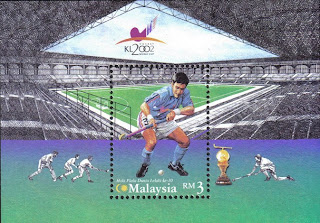Stamps Classification : Malaysia Engineering Stamp
Engineering has been an integral part in the development of many nations. Great strides have been made in the development of Malaysia ever since we gained our independence in 1957.
Closely associated with the nation's progress is The Institute of Engineers Malaysia (IEM) which was established in 1959 with the intention to reflect the independence of Malaysian engineers professionally.
In the last 50 years since its inception, IEM as the prime mover of nation building, have strived to promote sound professional engineering practice amongst its members and enhance sound professional engineering practices amongst its members and enhance society's consciousness of science and technology. The Strategic Plan drafted in 1997 was to steer the Institution towards becoming the premier professional organization that is pivotal to Malaysia achieving Vision 2020.
 Transportation and Ports
Transportation and PortsPorts: Penang Port is the transshipment hub of the Indonesia-Malaysia-Thailand growth triangle. Port Klang has world-class facilities while the nearby Westport is reputed as the "Fastport, Flexiport and Gardenport of south-East Asia.
Air Transportation: Malaysia has 37 airports, five of which are international airports, 15 domestic airports and 17 Short Takeoff and Landing airstrips. The biggest airport, Kuala Lumpur International Airport (KLIA) can handle 25 million passengers per annum and 1.2 million tons of cargo.
Railway: Peninsular Malaysia is served by railway lines which link the country with Thailand and Singapore as well as another line to the east coast state of Kelantan. The modern city of Kuala Lumpur boasts of an electric commuter train, the KTM Komuter, Light Rail Transport (LRT) and Monorail. Meanwhile, the Express Rail links the city to KLIA.
 Road Bridge & Dam
Road Bridge & DamRoads: With an estimated 95% of the goods transported by road, Malaysia’s modern road infrastructure has won praises from foreign investors. The modern North-South Highway and the East-West Highway make it easy to travel by road to any destination in the country.
Bridge: Bridges are an important element in establishing communication links between towns and cities that are separated by difficult terrain or rivers. The role of bridges has been important in the economic and social development of Malaysia’s enabling transportation links in moving people and goods.
Dams: The country enjoys high rainfall as well as an extensive network of more than 150 rivers that are sources of water supply. Most Malaysian buildings are served by piped water.
 Telecommunication and Power
Telecommunication and PowerElectricity: To promote renewable energy the Government initiated the Malaysia Building Integrated Photovoltaic (MPIPV) project in July 2005 to encourage renewable energy among the public and speed up development of a sustainable local market.
Telecommunication: The National Telecommunication Policy boosted the growth of telecommunication technology and services to support the nation’s development. A multi0million ringgit high speed broadband infrastructure project focusing on the Klang Valley and the Iskandar Development Region would be implemented over the next 10 years.
Information Technology: Both the rapid development of the telecommunication infrastructure and the expansion of the electronics industry have ushered in the Information Technology era in Malaysia. The ambitious Multimedia Super Corridor has further the growth of the Information Computer Technology (ICT).





















